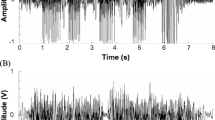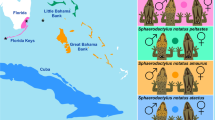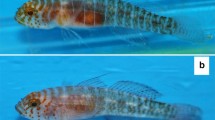Abstract
Distinguishing among courtship signals can be extremely important for individuals in regions where related species co-occur, including among sympatric species pairs and along hybrid zones. Reef habitats off the coast of Belize are shared by bioluminescent ostracods that perform nightly bioluminescent displays used in courtship. These displays vary in light pulse durations, interpulse distances and intervals, and direction. Here, we test how six sympatric species of marine ostracods (three described and three undescribed species) partition the display arena in time and space. Males from all six species can be differentiated based on morphology and species-specific luminescent display traits. Timing of nightly courtship display initiation and peak display timing differed among species by 5–25 min, and the order of appearance for each species was consistent across nights. In addition to varying temporally, species used different microhabitats (grassbed, sand channels, reef slopes and reef crest) for their courtship displays. Our findings support the hypothesis that species with more similar display traits (pulse duration, interpulse distance, number of pulses) differ most in the time and space used for courtship. The large number of axes for displacement of both luminescent display traits and spatio-temporal habitat use for courtship suggests that ostracods have the genetic toolkit for rapid diversification. This species complex living in sympatry yields a rich system for testing how genetic determination of behavioral traits relates to sexual selection and speciation.










Similar content being viewed by others
References
Abbot P, Withgott JR (2004) Phylogenetic and molecular evidence for allochronic speciation in gall-forming aphids (Pemphigus). Evolution 58:539–553
Amézquita A, Flechas SV, Lima AP, Gasser H, Hödl W (2011) Acoustic interference and recognition space within a complex assemblage of dendrobatid frogs. PNAS 108:17058–17063
Baeza JA, Thiel M (2003) Predicting territorial behavior in symbiotic crabs using host characteristics: a comparative study and proposal of a model. Mar Biol 142:93–100
Braak CJF, Smilauer P (2012) Canoco reference manual and user’s guide: software for ordination (version 5.0). Microcomputer Power, Ithaca
Clarke KR, Gorley RN (2006) PRIMER v6: user manual/tutorial. PRIMER-E, Plymouth
Cohen AC, Morin JG (1986) Three new luminescent ostracodes of the genus Vargula Myodocopida, Cypridinidae) from the San Blas region of Panama. Contrib Sci Nat Hist Mus LA County 373:1–23
Cohen AC, Morin JG (1989) Six new luminescent ostracodes of the genus Vargula (Myodocopida: Cypridinidae) from the San Blas region of Panama. J Crustac Biol 9:297–340
Cohen AC, Morin JG (1990) Morphological relationships of bioluminescent Caribbean species of Vargula (Myodocopa). In: Whatley R, Maybury C (eds) Ostraocoda and global events. Chapman and Hall, New York, pp 381–400
Cohen AC, Morin JG (1993) The cypridinid copulatory limb and a new genus Kornickeria (Ostracoda: Myodocopida) with four new species of bioluminescent ostracods from the Caribbean. Zool J Linn Soc Lond 108:23–84
Cohen AC, Morin JG (2003) Sexual morphology, reproduction and the evolution of bioluminescence in Ostracoda. Paleontol Soc Papers 9:37–70
Cohen AC, Morin JG (2010) Two new bioluminescent ostracod genera. Enewton and hoteros (Myodocopida, Cypridinidae), and three new species from Jamaica. J Crustac Biol 30:1–55
Conway CJ (2011) Standardized North American marsh bird monitoring protocol. Waterbirds 34(3):319–346
Coyne JA, Orr HA (1989) Two rules of speciation. In: Endler JA, Otte D (eds) Speciation and its consequences. Sinauer, Sunderland
Danley PD, deCarvalho TN, Fergus DJ, Shaw KL (2007) Reproductive asynchrony and the divergence of Hawaiian crickets. Ethology 113:1125–1132
Dayan T, Simberloff D (2005) Ecological and community-wide character displacement: the next generation. Ecol Lett 8:875–894
Dieckmann U, Doebeli M (1999) On the origin of species by sympatric speciation. Nature 400:354–357
Fergus DJ, deCarvalho TN, Shaw KL (2011) Genetically regulated temporal variation of novel courtship elements in the Hawaiian cricket genus Laupala. Behav Genet 41:607–614
Gerhardt HC, Klump GM (1988) Masking of acoustic signals by the chorus background noise in the green treefrog: a limitation on mate choice. Anim Behav 36:1247–1249
Gerrish GA, Morin JG (2008) Life cycle of a bioluminescent marine ostracode, Vargula annecohenae (Myodocopida: Cypridinidae). J Crustac Biol 28:669–674
Gerrish GA, Morin JG, Rivers TJ, Patrawala Z (2009) Darkness as an ecological resource: the role of light in partitioning the nocturnal niche. Oecologia 160:525–536
Grafe TU (1996) The function of call alternation in the African reed frog (Hyperolius marmoratus): precise call timing prevents auditory masking. Behav Ecol Sociobiol 38:149–158
Hastings JW, Morin JG (1991) Bioluminescence. In: Prosser CL (ed) Neural and integrative animal physiology. Wiley Interscience, New York, pp 131–170
Huvard AL (1993) Structure of the light organ and immunocytochemical localization of luciferase in luminescent marine ostracods (Crustacea: Ostracoda: Cypridinidae). J Morphol 218:181–193
Lemmon EM (2009) Diversification of conspecific signals in sympatry: geographical overlap drives multidimensional reproductive character displacement in frogs. Evolution 63:1155–1170
Lloyd JE (1966) Studies on the flash communication system in Photinus fireflies. Miscellaneous Publications Museum of Zoology, no 130. University of Michigan, Ann Arbor, Michigan
Lloyd JE (1968) A new Photinus firefly, with notes on mating behavior and a possible case of character displacement (Coleoptera: Lampyridae). Coleopt Bull 22:1–10
Lloyd J (1997) Firefly mating ecology, selection and evolution. In: Choe JC, Crespi BJ (eds) The evolution of mating systems in insects and arachnids. Cambridge University Press, Cambridge, pp 184–192
Mantel N (1967) The detection of disease clustering and a generalized regression approach. Cancer Res 27(2):209–220
Morin JG (1986) “Firefleas” of the sea: luminescent signaling in marine ostracode crustaceans. Fla Entomol 69:105–121
Morin JG, Cohen AC (1988) Two new luminescent ostracods of the genus Vargula (Myodocopida L. Cypridinidae) from the San Blas Region of Panama. J Crustac Biol 8:620–638
Morin JG, Cohen AC (1991) Bioluminescent displays, courtship and reproduction in ostracodes. In: Bauer R, Martins J (eds) Crustacean sexual biology. Columbia University Press, New York, pp 1–16
Morin JG, Cohen AC (2010) It’s all about sex: Bioluminescent courtship displays, morphological variation and sexual selection in two new genera of Caribbean ostracods. J Crustac Biol 30:56–67
Pedroso SS, Barber I, Svensson O, Fonseca PJ, Amorim MCP (2013) Courtship sounds advertise species identity and male quality in sympatric Pomatoschistus spp. gobies. PLoS Biol 8:e64620
Preininger D, Boeckle M, Freudmann A (2013) Multimodal signaling in the small torrent frog (Micrixalus saxicola) in a complex acoustic environment. Behav Ecol Sociobiol 67:1449–1456
IBM Corp. Released 2014. IBM SPSS Statistics for Windows, Version 23.0. Armonk, NY: IBM Corp
Rivers TJ, Morin JG (2008) Complex sexual courtship displays by luminescent male marine ostracods. J Exp Biol 211:2252–2262
Rivers TJ, Morin JG (2009) Plasticity of alternative mating tactics of a marine bioluminescent ostracod. Anim Behav 78:723–734
Rivers TJ, Morin JG (2012) The relative cost of using luminescence for sex and defense: light budgets in cypridinid ostracods. J Exp Biol 215:2860–2868
Rivers TJ, Morin JG (2013) Female ostracods respond to and intercept artificial conspecific male luminescent courtship displays. Behav Ecol 24:877–887
Rosset A, Spadola L, Osman R (2004) OsiriX: an open-source software for navigating in multidimensional DICOM images. J Digit Imaging 17:205–216
Ruppé L, Clément G, Herrel A, Ballesta L, Décamps T, Kéver L, Parmentier E (2015) Environmental constraints drive the partitioning of the soundscape in fishes. PNAS 112:6092–6097
Schluter D, McPhail JD (1992) Ecological character displacement and speciation in sticklebacks. Am Nat 140:85–105
Schmidt AKD, Romer H, Riede K (2013) Spectral niche segregation and community organization in a tropical cricket assemblage. Behav Ecol 24(2):470–480
Shieh B-S, Liang S-H, Chiu Y-W (2015) Acoustic and temporal partitioning of cicada assemblages in city and mountain environments. PLoS ONE 10(1):e0116794
Stanger-Hall KF, Lloyd JE (2015) Flash signal evolution in Photinus fireflies: character displacement and signal exploitation in a visual communication system. Evolution 69:666–682
SYSTAT 13 (2007) SPSS Inc. Chicago
Tauber CA, Tauber MJ (1977) A genetic model for sympatric speciation through habitat diversification and seasonal isolation. Nature 268:702–705
Tauber E, Roe H, Costa R, Hennessy JM, Kyriacou CP (2003) Temporal mating isolation driven by a behavioral gene in Drosophila. Current Biol 13:140–145
Tilman D, Pacala SW (1993) The maintenance of species richness in plant communities. In: Rickleffs R, Schluter D (eds) Species diversity in ecological communities. University Press, Chicago, pp 13–25
Torgerson WS (1958) Theory and methods of scaling. Wiley, New York
Torres E, Cohen AC (2005) Vargula morini, a new species of bioluminescent ostracode (Myodocopida: Cypridinidae) from Belize and an associated copepod (Copepoda: Siphonostomatoida: Nicothoidae). J Crustac Biol 25:11–24
Torres E, Gonzalez VL (2007) Molecular phylogeny of Cypridinid Ostracodes and the evolution of bioluminescence. In: Proceedings of the 14th international symposium on bioluminescence and chemiluminescence: chemistry, biology and applications. World Scientific Publishing Company, New Jersey, pp 269–272
Torres E, Morin JG (2007) Vargula annecohenae, a new species of bioluminescent ostracode (Myodocopida: Cypridinidae) from Belize. J Crustac Biol 27:649–659
Walker TJ (1983) Diel patterns of calling nocturnal Orthoptera. In: Gwynne DT, Morris GK (eds) Orthopteran mating systems: sexual competition in a diverse group of insects. Westview Press, Boulder, pp 45–72
Witte K (2005) How cricket frog females deal with a noisy world: Habitat-related differences in auditory tuning. Behav Ecol 16:571–579
Wollerman L, Wiley RH (2002) Background noise from a natural chorus alters female discrimination of male calls in a neotropical frog. Anim Behav 63:15–22
Acknowledgments
Thank you to editor Martin Thiel, three reviewers for feedback and edits on our original submission. We would like to thank Colleen Kearns and Hilary Kates for assistance with data collection. We thank Nelson Hairston Jr. and Amy McCune for feedback on experimental design and early drafts of the manuscript. Mark Riccio of the Cornell University Institute of Biotechnology Imaging Facility assisted in the micro-CT scanning of the specimens. We give a special thanks in memorium to Victor Orlando Escobar (1974–2014), our beloved Belizean field guide who assisted with this research. Funding was provided by the Mario Einaudi International Fund at Cornell University, the Lerner Grey Fund for Marine Science and the Andrew W. Mellon Foundation. All work was completed in accordance with permits obtained from the Belize Department of Fisheries.
Author information
Authors and Affiliations
Corresponding author
Ethics declarations
Conflict of interest
The authors declare that they know of no conflicts of interest pertaining to the work submitted.
Funding
Funding was provided by the Mario Einaudi International Fund at Cornell University, the Lerner Grey Fund for Marine Science and the Andrew W. Mellon Foundation. (Grant numbers not available).
Ethical standard
No vertebrate animals or human participants were used in this study. All applicable international, national and/or institutional guidelines for the care and use of animals were followed. All work was done in compliance with permits from the Department of Fisheries, Belize.
Additional information
Responsible Editor: M. Thiel.
Reviewed by A. Palaoro, J. H. Christy and an undisclosed expert.
Rights and permissions
About this article
Cite this article
Gerrish, G.A., Morin, J.G. Living in sympatry via differentiation in time, space and display characters of courtship behaviors of bioluminescent marine ostracods. Mar Biol 163, 190 (2016). https://doi.org/10.1007/s00227-016-2960-5
Received:
Accepted:
Published:
DOI: https://doi.org/10.1007/s00227-016-2960-5




